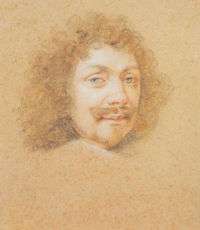Henri Louis Habert de Montmor
Henri Louis Habert de Montmor (c. 1600, Paris – 21 January 1679, Paris) was a French scholar and man of letters.

Pastel and crayon by Claude Mellan.
Biography
Cousin to Philippe Habert and Germain Habert, he became conseiller du roi aged 25, then in 1632 rose to become maître des requêtes, a post he gained thanks to the fortune of his father, treasurer extraordinary for war and treasurer of savings.
He married Henriette-Marie de Buade, sister of Louis de Buade de Frontenac, future governor of New France. He attended on Marie de Gournay and wrote Latin epigrams. In 1634, he was elected an inaugural member of the Académie française, pronouncing its fifth discourse but soon becoming a dissenting member as well as its last inaugural member to die.
An avid supporter of Descartes, Habert wrote a poem on Cartesian physics entitled De rerum naturae and collected scientific instruments. He was a friend of Mersenne, who dedicated his Harmonie Universelle to Montmor, and a great friend of Pierre Gassendi, who dedicated to him his Life of Tycho Brahe. Gassendi also left him an astronomical telescope he had been left by Galileo. Three years after Gassendi's death, Habert edited his complete works in 6 volumes, writing its Latin preface.
Besides Gassendi, he gathered a salon of savants and philosophers which included, among others: Pierre Daniel Huet, Jean Chapelain, Adrien Auzout, Girard Desargues, Samuel Sorbière, Claude Clerselier, Jacques Rohault, Guy Patin, Frénicle de Bessy, Pierre Petit, Melchisédech Thévenot, Roberval and Huygens.
They were all passionate about scientific experiments and formed in 1657 the "Académie Montmor", which was based in his house.[1] It ceased to exist in 1664 as a result of petty squabbles, but one of the members, Adrien Auzout, indicated in a letter of dedication to Louis XIV in 1664 that there was a need for a public observatory, and that there was a group ready to begin its work if it received royal sponsorship. A proposed constitution was circulated to former Academy members but numerous modifications were made before the Académie des sciences was finally created in 1666.[2]
See also
References
- Brown, Harcourt (1934). Scientific organization in seventeenth century France. Baltimore: The Williams and Wilkins Company. p. 74.
- "Académie de Montmor = Academy of Montmor". U of Waterloo Library. Archived from the original on 6 October 2013. Retrieved 8 Nov 2013.
External links
- Biography on the Galileo Project
- (in French) Habert de Montmor family
- (in French) Biography on the Académie française site